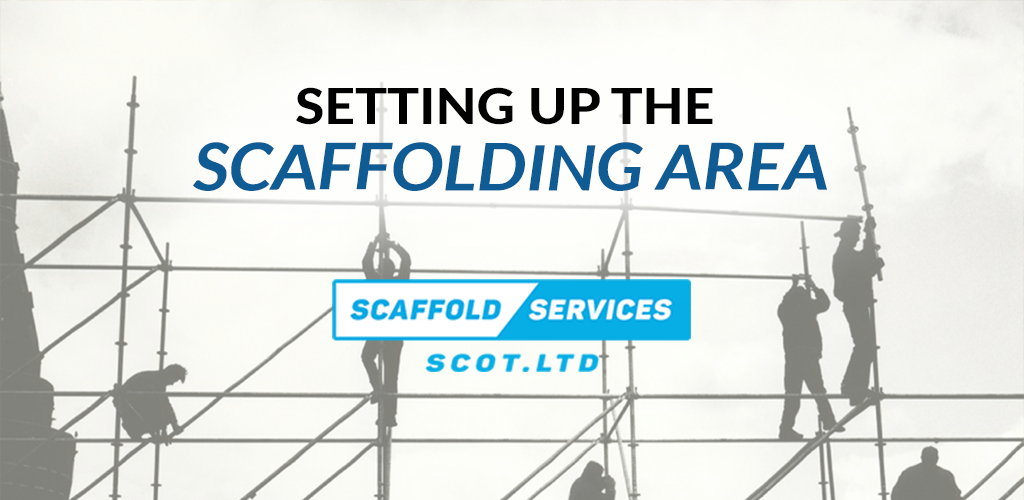Scaffolding Hire Scotland: Setting Up the Scaffolding Area

Scaffolding any type of access is not just as simple as hiring or buying scaffolding, followed by quick installation.
Setting up the scaffolding area, regardless of scaffolding hire or purchase scaffolding, requires site assessment, risk assessment and supply of scaffolding, designed to accommodate the individual projects complexities. Once the scaffolding has been installed and the structure is sound and stable, responsibilities of the contractor, don’t end there.
The newly installed scaffolding structure must then be fully managed and regularly inspected to ensure its safety for those working on the structure and those in proximity.
Site Assessment and Risk Assessment
Before any type of access can be provided, a full onsite assessment must be conducted to take into account any uneven or soft ground conditions, building complexities and any additional hazards or risks posed by the environment.
Once complete, the correct type of scaffolding alongside any additional safety solutions can be provided, tailored to the environment, project and the type of works intended to be carried out.
Site Checks and Preparation
Delivery of Scaffolding – Once the scaffolding required for the project at hand has been designed to cater for the specifications and complexities of the building access is required to, the scaffolding supplier or contractor will then have the equipment delivered to the site.
Site Inductions – All persons intended to be onsite for the installation must also ensure they have undergone a site induction and understood all health and safety aspects.
Personal Protective Equipment (PPE) – First and foremost before entering the site you must make sure you have the correct PPE and high visibility clothing. This includes; High Visibility Vest, Boots, Hard Hat, Ear Protectors, Eye Protection and Gloves – as applicable. Check with the site manager the required PPE for the site you intend to install the scaffolding, if not already covered in the site induction.
Scaffolding Unloading Area – Upon arrival, the site manager or supervisor should be notified to direct the scaffolding for unloading to the appropriate location. Ideally, the scaffolding should be unloaded as close as possible to the erection / installation site to reduce manual handling as much as possible.
Environment and Proximity Check – Ensure before unloading any scaffolding, scaffolding supplies or equipment, the unloading area and subsequent unloading of the scaffolding, does not or will not interfere with;
- Any moving traffic on the site
- Obstruct or block any emergency exits, access points or egress points for traffic, moving machinery or people
- Puts any workers, drivers or operatives at risk or danger
- Blocks or obscures thoroughfares
- Places general public or site visitors at risk or danger
Unloading of Scaffolding and Scaffolding Supplies
Unloading of the Scaffolding – Generally is a two-fold task requiring the use of the correct lifting equipment, commonly a Hiab, alongside manual handling of scaffolding components and supplies.
Grouping Scaffolding, Supplies and Components – Unload the scaffolding starting with the topmost items. Arranging the various components and additional accessories and scaffolding safety products into groups on the ground, permitting a faster more efficient installation.
Stacking Scaffolding and Supplies – Never stack heavier items on top of lighter items, due to the risk in damaging the structure and safety of the item, never stack anything on top of ladders. Remember to lay scaffolding frames, flat to avoid bending or any distortion, which will result in the safety of the structure being affected alongside its load bearing ability.
Scaffolding Installation
Scaffolding regardless of type, must always be erected by trained and qualified persons. Once the scaffolding has been fully installed, the safety of the structure must then be inspected.
Scaffolding inspection upon installation is essential, however not the only inspection required. A project manager or scaffolding contractor responsible must also incorporate a scaffolding management system.
Scaffolding Management
Scaffolding management is the responsibility of the assigned scaffolding contractor or project manager. Management and inspection of a scaffolding structure doesn’t just begin and end at the point of installation.
Once installed a regular, weekly scaffolding inspection procedure must be adopted, one of the most popular ways to manage inspection of scaffolding is by using a Scafftag and Laddertag system.
Scafftags provide a quick visual of each lift of the scaffolding structure, located usually at one end of each lift, clearly detailing when the lift was last inspected, any defects, damage or replaced components.
In Summary
When looking for scaffolding to provide access to a project at hand, there’s a lot more to be considered and responsible for than simply just finding the right scaffolding at the right price.
If you’d like some advice or support in supplying your project with the right scaffolding at the right price, or to discuss scaffolding hire or buy options, contact Scaffold Services Scotland on – 0141 779 2861 or email us at – info@scaffoldservices.scot
